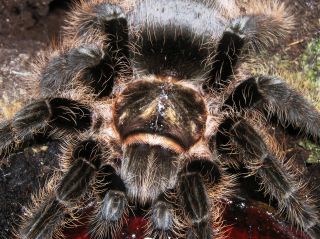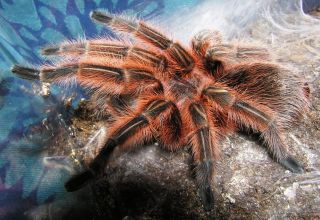|
Being the spider geek that I am, of course I have a few pet spiders too! Here you can read about some of the invertebrates sharing my home, and a little about spiders as pets in general.

Exotic pets are getting increasingly popular in Sweden, among them spiders and in particular tarantulas - for both good and bad. Tarantulas as pets are beautiful, easy to keep, and with many species to choose from. One important thing concerning spiders as pets is however that they are not pets that should be petted! Keeping spiders should rather be compared to keeping tropical fish - look but do not touch! Not beacause the animals are dangerous, but for the sake of the spider. Spiders are, with very few exceptions, the most asocial animals imaginable. Any form of social interaction with a human is never in the interest of the spider, and they can be negatively affected by the stress involved (and that includes calm, docile species that tolerates being handled - tolerating is not the same as liking).
For good and bad yes...as a tarantula owner I often get the question why I keep spiders as pets. And why I want them if I do not pet and handle them (see above). Have anyone ever got that question about tropical fish? Not me! In the fish case it seems to be obvious that animals can be kept for no other reason than being beautiful and interesting...
Spiders are a rather misunderstood animal group, where general knowledge is often lacking, both in authorities and the general community. That they are getting more common as pets hopefully means that interest in spiders in general is increasing, which in the long run may lead to better knowledge about them both in nature and in captivity (most spiders seen in Swedish pet shops today are for example not correctly cared for - people who buy them risk getting a pet that is stressed, and also will not receive correct information about its care). An increasing interest for spiders in their natural habitats can also lead to increasing interest in, and knowledge about, conservation work aimed at these animals.
Which unfortunately is needed, and for some species as a direct consequence of the pet trade. Knowledge about many tarantula species (and other exotic animals kept as pets too, of course) in the wild is often lacking, and as a result so is the knowledge about how natural populations and ecosystems are affected by the capture of wild animals. For some species the pet trade is a very real threat - the whole genus Brachypelma (to which for example the classic black-and-orange tarantulas belong) has for example been CITES-listed (CITES = Convention on International Trade with Endangered Species) for a long time now, much as a consequence of the popularity of Brachypelma species as pets. In addition, when importing exotic animals there is also a risk of importing other unwanted organisms with them, such as diseases and parasites that affect the spiders in their natural habitats.
From this can be concluded that a certain amount of responsibility is needed when keeping exotic animals as pets, in particular such species that to some extent are still captured in the wild. Many tarantula species are quite easy to breed in captivity, and it is often very possible to choose such individuals above wild caught ones - especially where the most common pet species are concerned (for example those that I keep). It is also easy to check whether the species is on the CITES-list before buying a wild-caught, imported spider.
|
|
My spiders
Six adult tarantulas and one scorpion share my home, all of them females. All my spiders are species that are common as pets, easy to keep, quite calm and docile - I am personally not interested in keeping as many different species as possible or keeping dangerous species. I am mostly interested in spiders in nature, so the tarantulas are for me a way of including eight-legged animals in my life even during the rather long part of the year when there is not much to look at outdoors in Scandinavia where spiders and other invertebrates are concerned.
Tarantula keeping
My tarantulas live in terrariums with a layer of peat moss, a water bowl, hiding places such as pieces of wood or bark or a half flower pot, and maybe a few plants. They eat insects, mostly captive-bred crickets or cockroaches, but also some wild caught insects such as grasshoppers during summer. None of my spiders are very venomous even should they bite - a bite is in most cases comparable to that a bee or wasp sting, except that spider venom tends to be less allergenic. American spiders however prefer to defend themselves using urticating hairs on their abdomen, that are thrown or rubbed off when the spider feel threatened. The hairs are irritating and unpleasant, but not dangerous.

|